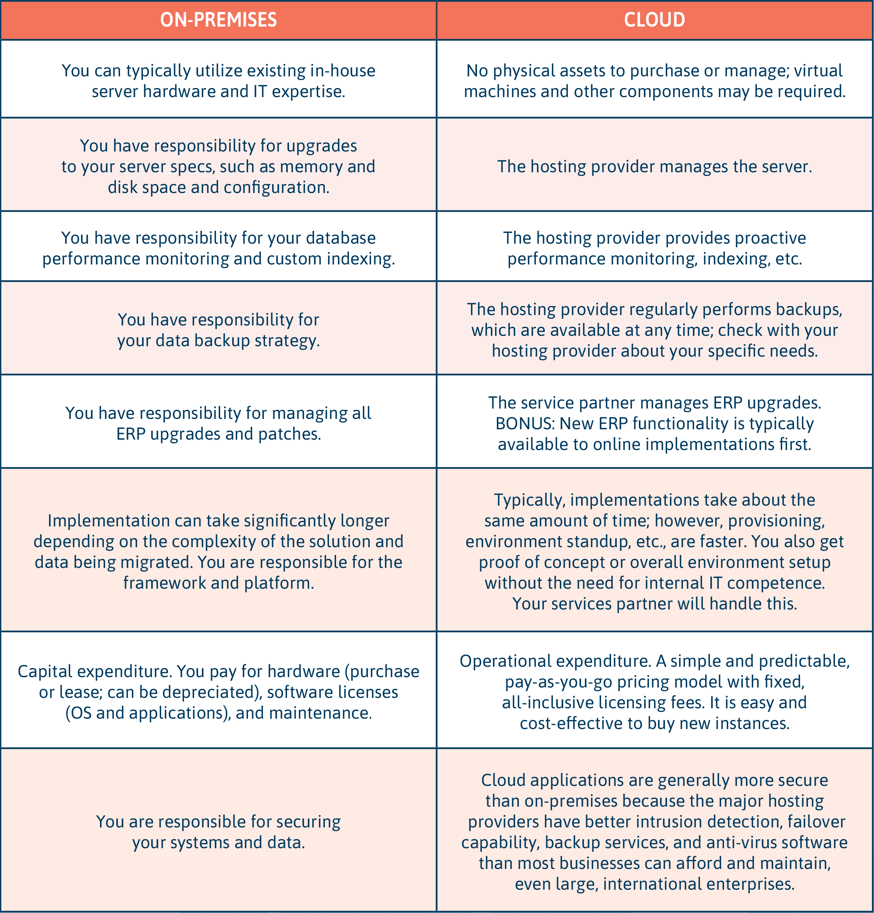Keep reading
How the Cloud Has Surpassed On-Premise Technology
Making the case for Microsoft ERP in the cloud
Your company is ready for a new financial management or ERP system. And now you have to decide if you should go with a cloud solution. How do you make your decision and recommendation with confidence?
According to HubSpot, 86% of ERP software is deployed in the cloud, and Beroe, Inc., reported that the cloud ERP market is expected to grow 10 percent CAGR by 2025. Today, the cloud is the preferred platform for many of the world’s leading businesses—due in part to the increased use of social media, mobile workforces, the internet—but also because the cloud has surpassed on- premises technology in a surprising number of ways.
But that’s true only for managing customer relationships, right? Maybe payroll. But not for core financial or manufacturing operations. That data is too sensitive and processes are too complex.
NOT SO.
If you are reading this blog, you likely fall into one of two camps: You are an advocate for moving your ERP to the cloud and need buy-in from key stakeholders, or you are a skeptic—not convinced the cloud can handle your financials and business processes.
This blog is designed to address both positions by laying out the case for the cloud and illustrating how a cloud-based solution is superior to its on-premise counterpart when it comes to supporting your finance team. Advocates are armed with the data points they need to build a convincing case, and skeptics will walk away not only less skeptical, but excited about the possibilities presented by the cloud.
However, as with any important decision—and this is especially true for technology—defining your requirements and the best way to address them will go a long way towards making a decision you can feel confident about.
The key is to not make a decision based on fear or misinformation. If you understand exactly what the cloud has to offer and are very clear on your organization’s structure, operations, challenges, and strategic goals, you can determine if it is the right fit for you.
In the end, we believe you will see what other leading organizations have seen—that ERP, Microsoft or other, in the cloud is not only a viable choice, but the right choice.
The basics: How cloud and on-premises differ
Before diving into a discussion of the advantages the cloud presents to CFOs, let’s start with being clear about the basic differences between an application deployed in the cloud versus an on-premises deployment:

The first step is to understand the typical differences between the two deployment strategies.
Understand the advantages of the Microsoft ERP cloud for Finance
The argument for the cloud to help your business transition to modern finance is a convincing one when you look at the benefits:
Today, the importance of using data to make critical decisions is paramount—a competitive differentiator. And as discussed earlier, surfacing intelligence and insights and reporting on that information has become much more sophisticated and predictive with developments like AI and machine learning. The cloud modernizes these processes so you can make informed decisions in real time because you have easy access to timely, accurate, reliable, and verifiable financial data. By giving you the ability to tightly integrate all your operational systems, you get a single source of truth that you can use to build actionable intelligence and deliver more value to the business—which is either very challenging or impossible to do with on-premises technology.
With the cloud, you have the tools you need to automate and streamline workflows and processes, optimizing the productivity of your workforce and allowing them to focus their efforts on areas that add more value—or do more with less if conditions require, eliminating the need to make staff reductions or hire new staff. You also get the benefit of a dramatically shorter learning curve.
The productivity of your team depends partly on their ability to collaborate effectively. Cloud ERP solutions like Microsoft Dynamics 365 integrate seamlessly with Outlook, Teams, and more, making ERP data, reports, and workflow approvals immediately available—again, without compromising on security and without having to change the productivity tools you have invested in and your people are comfortable using.
Security and compliance are always top of mind for a CFO— especially when it comes to your technology. Reputable cloud software is continuously updated with regulatory certifications, reducing your exposure and protecting your reputation. The cloud ensures other areas like secure connectivity with vendors and partners, enabling you to put controls in place to protect your organization against fraud and cyberattacks.
With the pandemic came the immediate requirement to be able to work from anywhere. Businesses realized that there are many benefits to providing mobility in addition to enabling remote work. Cloud systems are inherently “work anywhere ready,” accommodating work from the office, home, or a combination. Cloud solutions are even accessible through mobile devices, with workflows for many processes, like submitting and approving expense reports, purchase requisitions, or vendor invoices. And because these solutions are in the cloud and being accessed through a browser, employees can be productive without compromising on security.
Across the nation, businesses of all types have been struggling with “the great resignation.” Business leaders and CFOs need to make their organizations attractive to talent that is in demand. It is imperative to offer positions that are supported by modern enterprise systems with capabilities that not only reduce frustration but also keep their skills and talents up to date.
ERP Modernization in the Cloud
There are many more benefits to modernizing finance with cloud technology, with every benefit resulting in cost savings and/or revenue growth. Predictive insights, fraud prevention, automated and streamlined processes, reduced IT footprint, mobility—it all adds up to a healthier bottom line for your business.


Size up your organization
Regardless of which financial management or ERP solution you choose, the decision to go to the cloud hinges on your business requirements, challenges, and goals. No single thing should make or break the decision, and you should not assume that you have to compromise on what you need. Start by getting detailed answers to the following questions:
The cloud typically requires the same implementation time; however, as with any implementation, that varies based on the complexity of your solution, and provisioning is definitely faster.
A hosting provider must be able to offer the level of security you require and be able to satisfy any security regulations to which your organization must comply. Some think the cloud is not as secure as on premises, but that is not true. Microsoft, for example, holds more national, international, and industry specific certifications, credentials, and compliance approvals than nearly any single company could obtain on its own.
Are your employees remote, on your company network, or a combination? Remote employees are more common than ever before. Cloud ERP can be implemented as an extension of your own network, with all the security controls you use today—or it can be designed with full-fledged public access—or anywhere in between. You decide based on your processes and policies.
Integrating with other systems can be simple or more involved and time-consuming, depending on the number and type and whether the system is also in the cloud or is on-premises.
We have gone past mere reporting. Today, the cloud means machine learning and proactive analytics, which the cloud is more capable of providing than an on-premises solution.
With either option, you need to have a solid backup plan. Today’s cloud can provide you with as much control and flexibility as you require.
Choose your cloud ERP solution
The next step is to choose an ERP software application and a provider. There are many options, but the information provided in this blog should give you an idea of what you should be looking for so you can narrow down your choices. As a long-time Microsoft partner, we know first-hand the benefits Microsoft Dynamics 365 offers, and we believe any ERP under consideration should offer the same:


Why HSO for Microsoft ERP in the cloud?
With over thirty years of working with businesses around the world to design and implement financial management and ERP systems, we use the factors discussed in this guide in every engagement. We walk through them with our clients to help determine the right strategy for their business. With the advancements in cloud technology represented by Dynamics 365, Azure, and other Microsoft products, we believe the cloud is a viable option for nearly any organization.
If you’re considering Microsoft Dynamics 365 Finance (ERP), the SaaS (online) option is more popular based on Microsoft’s consistent investment and provided incentives, as well as successful deployments.
Keep reading
How the Cloud Has Surpassed On-Premise Technology
If you are evaluating ERP or financial management solutions and are considering the cloud, contact us to see what HSO has to offer.
We, and third parties, use cookies on our website. We use cookies to keep statistics, to save your preferences, but also for marketing purposes (for example, tailoring advertisements). By clicking on 'Settings' you can read more about our cookies and adjust your preferences. By clicking 'Accept all', you agree to the use of all cookies as described in our privacy and cookie policy.
Purpose
This cookie is used to store your preferences regarding cookies. The history is stored in your local storage.
Cookies
Location of Processing
European Union
Technologies Used
Cookies
Expiration date
1 year
Why required?
Required web technologies and cookies make our website technically accessible to and usable for you. This applies to essential base functionalities such as navigation on the website, correct display in your internet browser or requesting your consent. Without these web technologies and cookies our website does not work.
Purpose
These cookies are stored to keep you logged into the website.
Cookies
Location of Processing
European Union
Technologies Used
Cookies
Expiration date
1 year
Why required?
Required web technologies and cookies make our website technically accessible to and usable for you. This applies to essential base functionalities such as navigation on the website, correct display in your internet browser or requesting your consent. Without these web technologies and cookies our website does not work.
Purpose
This cookie is used to submit forms to us in a safe way.
Cookies
Location of Processing
European Union
Technologies Used
Cookies
Expiration date
1 year
Why required?
Required web technologies and cookies make our website technically accessible to and usable for you. This applies to essential base functionalities such as navigation on the website, correct display in your internet browser or requesting your consent. Without these web technologies and cookies our website does not work.
Purpose
This service provided by Google is used to load specific tags (or trackers) based on your preferences and location.
Why required?
This web technology enables us to insert tags based on your preferences. It is required but adheres to your settings and will not load any tags if you do not consent to them.
Purpose
This cookie is used to store your preferences regarding language.
Cookies
Why required?
We use your browser language to determine which language to show on our website. When you change the default language, this cookie makes sure your language preference is persistent.
Purpose
This service is used to track anonymized analytics on the HSO.com application. We find it very important that your privacy is protected. Therefore, we collect and store this data anonymously on our own servers. This cookie helps us collect data from HSO.com so that we can improve the website. Examples of this are: it allows us to track engagement by page, measuring various events like scroll-depth, time on page and clicks.
Cookie
Purpose
With your consent, this website will load Google Analytics to track behavior across the site.
Cookies
Purpose
With your consent, this website will load the Google Advertising tag which enables HSO to report user activity from HSO.com to Google. This enables HSO to track conversions and create remarketing lists based on user activity on HSO.com.
Possible cookies
Please refer to the below page for an updated view of all possible cookies that the Google Ads tag may set.
Cookie information for Google's ad products (safety.google)
Technologies Used
Cookies
Purpose
With your consent, we use IPGeoLocation to retrieve a country code based on your IP address. We use this service to be able to trigger the right web technologies for the right people.
Purpose
With your consent, we use Leadfeeder to identify companies by their IP-addresses. Leadfeeder automatically filters out all users visiting from residential IP addresses and ISPs. All visit data is aggregated on the company level.
Cookies
Purpose
With your consent, this website will load the LinkedIn Insights tag which enables us to see analytical data on website performance, allows us to build audiences, and use retargeting as an advertising technique. Learn more about LinkedIn cookies here.
Cookies
Purpose
With your consent, this website will load the Microsoft Advertising Universal Event Tracking tag which enables HSO to report user activity from HSO.com to Microsoft Advertising. HSO can then create conversion goals to specify which subset of user actions on the website qualify to be counted as conversions. Similarly, HSO can create remarketing lists based on user activity on HSO.com and Microsoft Advertising matches the list definitions with UET logged user activity to put users into those lists.
Cookies
Technologies Used
Cookies
Purpose
With your consent, this website will load the Microsoft Dynamics 365 Marketing tag which enables HSO to score leads based on your level of interaction with the website. The cookie contains no personal information, but does uniquely identify a specific browser on a specific machine. Learn more about Microsoft Dynamics 365 Marketing cookies here.
Cookies
Technologies Used
Cookies
Purpose
With your consent, we use Spotler to measures more extensive recurring website visits based on IP address and draw up a profile of a visitor.
Cookies
Purpose
With your consent, this website will show videos embedded from Vimeo.
Technologies Used
Cookies
Purpose
With your consent, this website will show videos embedded from Youtube.
Cookies
Technologies Used
Cookies
Purpose
With your consent, this website will load the Meta-pixel tag which enables us to see analytical data on website performance, allows us to build audiences, and use retargeting as an advertising technique through platforms owned by Meta, like Facebook and Instagram. Learn more about Facebook cookies here. You can adjust how ads work for you on Facebook here.
Cookies
Purpose
With your consent, we use LeadInfo to identify companies by their IP-addresses. LeadInfo automatically filters out all users visiting from residential IP addresses and ISPs. These cookies are not shared with third parties under any circumstances.
Cookies
Purpose
With your consent, we use TechTarget to identify companies by their IP address(es).
Cookies
Purpose
With your consent, we use this service provided by uMarketingSuite to run A/B tests across the HSO.com application. A/B testing (also called split testing) is comparing two versions of a web page to learn how we can improve your experience.
Purpose
With your consent, we use this service provided by uMarketingSuite to personalize pages and content across the HSO.com application. Personalization helps us to tailor the website to your specific needs, aiming to improve your experience on HSO.com.
Purpose
With your consent, we use ZoomInfo to identify companies by their IP addresses. The data collected helps us understand which companies are visiting our website, enabling us to target sales and marketing efforts more effectively.
Cookies